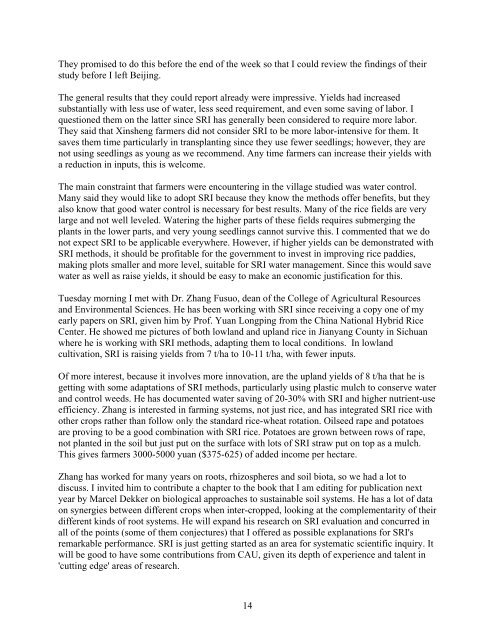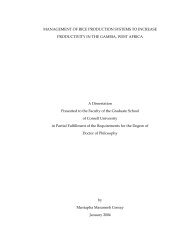Report from SRI China visit - The System of Rice Intensification ...
Report from SRI China visit - The System of Rice Intensification ...
Report from SRI China visit - The System of Rice Intensification ...
You also want an ePaper? Increase the reach of your titles
YUMPU automatically turns print PDFs into web optimized ePapers that Google loves.
<strong>The</strong>y promised to do this before the end <strong>of</strong> the week so that I could review the findings <strong>of</strong> their<br />
study before I left Beijing.<br />
<strong>The</strong> general results that they could report already were impressive. Yields had increased<br />
substantially with less use <strong>of</strong> water, less seed requirement, and even some saving <strong>of</strong> labor. I<br />
questioned them on the latter since <strong>SRI</strong> has generally been considered to require more labor.<br />
<strong>The</strong>y said that Xinsheng farmers did not consider <strong>SRI</strong> to be more labor-intensive for them. It<br />
saves them time particularly in transplanting since they use fewer seedlings; however, they are<br />
not using seedlings as young as we recommend. Any time farmers can increase their yields with<br />
a reduction in inputs, this is welcome.<br />
<strong>The</strong> main constraint that farmers were encountering in the village studied was water control.<br />
Many said they would like to adopt <strong>SRI</strong> because they know the methods <strong>of</strong>fer benefits, but they<br />
also know that good water control is necessary for best results. Many <strong>of</strong> the rice fields are very<br />
large and not well leveled. Watering the higher parts <strong>of</strong> these fields requires submerging the<br />
plants in the lower parts, and very young seedlings cannot survive this. I commented that we do<br />
not expect <strong>SRI</strong> to be applicable everywhere. However, if higher yields can be demonstrated with<br />
<strong>SRI</strong> methods, it should be pr<strong>of</strong>itable for the government to invest in improving rice paddies,<br />
making plots smaller and more level, suitable for <strong>SRI</strong> water management. Since this would save<br />
water as well as raise yields, it should be easy to make an economic justification for this.<br />
Tuesday morning I met with Dr. Zhang Fusuo, dean <strong>of</strong> the College <strong>of</strong> Agricultural Resources<br />
and Environmental Sciences. He has been working with <strong>SRI</strong> since receiving a copy one <strong>of</strong> my<br />
early papers on <strong>SRI</strong>, given him by Pr<strong>of</strong>. Yuan Longping <strong>from</strong> the <strong>China</strong> National Hybrid <strong>Rice</strong><br />
Center. He showed me pictures <strong>of</strong> both lowland and upland rice in Jianyang County in Sichuan<br />
where he is working with <strong>SRI</strong> methods, adapting them to local conditions. In lowland<br />
cultivation, <strong>SRI</strong> is raising yields <strong>from</strong> 7 t/ha to 10-11 t/ha, with fewer inputs.<br />
Of more interest, because it involves more innovation, are the upland yields <strong>of</strong> 8 t/ha that he is<br />
getting with some adaptations <strong>of</strong> <strong>SRI</strong> methods, particularly using plastic mulch to conserve water<br />
and control weeds. He has documented water saving <strong>of</strong> 20-30% with <strong>SRI</strong> and higher nutrient-use<br />
efficiency. Zhang is interested in farming systems, not just rice, and has integrated <strong>SRI</strong> rice with<br />
other crops rather than follow only the standard rice-wheat rotation. Oilseed rape and potatoes<br />
are proving to be a good combination with <strong>SRI</strong> rice. Potatoes are grown between rows <strong>of</strong> rape,<br />
not planted in the soil but just put on the surface with lots <strong>of</strong> <strong>SRI</strong> straw put on top as a mulch.<br />
This gives farmers 3000-5000 yuan ($375-625) <strong>of</strong> added income per hectare.<br />
Zhang has worked for many years on roots, rhizospheres and soil biota, so we had a lot to<br />
discuss. I invited him to contribute a chapter to the book that I am editing for publication next<br />
year by Marcel Dekker on biological approaches to sustainable soil systems. He has a lot <strong>of</strong> data<br />
on synergies between different crops when inter-cropped, looking at the complementarity <strong>of</strong> their<br />
different kinds <strong>of</strong> root systems. He will expand his research on <strong>SRI</strong> evaluation and concurred in<br />
all <strong>of</strong> the points (some <strong>of</strong> them conjectures) that I <strong>of</strong>fered as possible explanations for <strong>SRI</strong>'s<br />
remarkable performance. <strong>SRI</strong> is just getting started as an area for systematic scientific inquiry. It<br />
will be good to have some contributions <strong>from</strong> CAU, given its depth <strong>of</strong> experience and talent in<br />
'cutting edge' areas <strong>of</strong> research.<br />
14
















